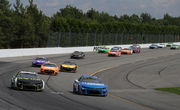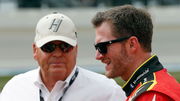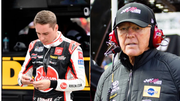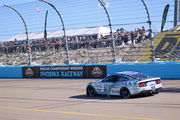
via Imago
NASCAR driver Shane van Gisbergen

via Imago
NASCAR driver Shane van Gisbergen
Shane van Gisbergen knows a thing or two about mastering a race car. Three Australian Supercars titles and a reputation for making high-speed, high-commitment road courses look easy have cemented him as one of the most versatile drivers in the world. In Australia, he spent years threading the needle through circuits with a mix of blind apexes, rapid elevation changes, and unpredictable surfaces—never knowing if a surprise rain shower or a moment of lost traction would end his day in the blink of an eye.
So when he made the leap to NASCAR, he assumed one thing: superspeedway racing would be boring as hell.
After all, what’s so difficult about mashing the throttle and holding it flat for 500 miles? That was the thought—until he actually got behind the wheel in a Cup Series car, staring down 35 drivers who would sooner push him into the fence than give him an inch of space.
ADVERTISEMENT
Article continues below this ad
Turns out, he’s got a whole new opinion now.
SVG’s shocked about superspeedway racing: “You got 35 Maniacs around you”
When Shane van Gisbergen first watched superspeedway racing on TV, he couldn’t understand the appeal. “I thought it was just driving around in circles,” he recalls. But his perspective shifted the moment he climbed into a Cup Series car for his first superspeedway practice.
In a recent interview SVG didn’t hold back when recalling his first real taste of superspeedway racing during a practice session at Daytona.
“Yeah, this practice and qualifying stuff’s boring,” he said. “It’s amazing, you just drive around one-handed blocking the air.”
But then he got to race mode.
What’s your perspective on:
Is NASCAR's chaotic pack racing the ultimate test for even the most seasoned Supercars champions?
Have an interesting take?
“It is, yeah, and you, just, you know you’re flicking switches and trying different things, and you just look at the lap time and you can’t really tell, but when you’re in the race, you’re going three or four seconds quicker, and you got 35 other maniacs around you. That’s when it’s epic.”
.@shanevg97 is not a huge fan of single car runs in practice at @DAYTONA.
The race? That’s a different story.
🤯 “When you’re in the race, you’re going 3-4 seconds a lap quicker. And you’ve got 35 other maniacs around ya. That’s when it’s epic.” pic.twitter.com/VdJYA3MmgA
— SiriusXM NASCAR Radio (Ch. 90) (@SiriusXMNASCAR) February 13, 2025
The tight, technical circuits of Supercars never prepared him for the sheer unpredictability of NASCAR pack racing. One moment you’re leading, the next, you’re boxed in three-wide with nowhere to go.
Shane van Gisbergen’s first real superspeedway experience came at Talladega in 2024, and it was a baptism by fire. He vividly remembers the infamous “Big One,” a massive crash that’s a hallmark of superspeedway racing. “There was a wreck in Turn 4, and I thought I should back down,” SVG recalled. SVG like most drivers instinctively backed off but Kyle Busch— two-time champion and consistently one of NASCAR’s most aggressive competitors—stayed flat out, driving straight into the chaos. “He just stayed flat out and drove into the crash carelessly,” SVG says, still in awe of Busch’s audacity. “His car was completely destroyed, but he gained three or four more points. My car was brand new and ready to race next week, but he finished ahead of me.”
Busch, somehow, still gained positions. SVG, in classic road racer fashion, finished with a clean car but fewer points. That’s when the realization hit: in superspeedway racing, sometimes the best strategy is simply throwing caution to the wind.
It was a moment that encapsulated the stark contrast between SVG’s Supercars background and the no-holds-barred mentality of NASCAR. “It’s like leading pigs to slaughter,” he says of the superspeedway approach. “They just treat the cars here like they’re disposable.” Yet, despite the initial shock, SVG has come to respect the skill and strategy involved. “There’s so much more to it than I realized,” he admits. “You’re always jockeying for position, fuel saving, and trying to place yourself in the right spots. It’s a constant mental game.”
Trending
Respect earned and respect given
When a driver from outside the NASCAR bubble steps in, they don’t always get a warm welcome. But SVG’s skill has turned heads quickly—especially among some of the biggest names in the sport.
Kyle Busch, one of the “maniacs” in questions, has also been one of his biggest supporters, praising him after his first Cup Series win in Chicago.
“(At Chicago) he had us all beat by probably six- to eight-tenths of a second a lap,” Busch admitted. “I would say going into Indy we should all be within two- or three-tenths, but he’ll still be the best guy.”
Kyle Larson, himself no stranger to dominating multiple disciplines, has been open about his admiration for SVG’s talent.
“Obviously, I would not expect to run very good because Shane van Gisbergen, he came in [to NASCAR] and kicked all of our b—-. So I know these Australian racers and Supercars drivers are extremely good.”
And then there’s Chase Elliott, who called SVG’s racecraft “classy” after his Cup debut victory.
“I thought his drive was not only impressive, but very classy. You didn’t see him running over people. He didn’t run over people to win the race. I thought he did it the right way. That is very admirable. I think people like that deserve great opportunities.”
ADVERTISEMENT
Article continues below this ad
SVG, for his part, has taken all this in stride. He’s still learning the ropes, still adapting to a completely new style of racing. But there’s no doubt—his respect for his competitors, and theirs for him, is growing every single race. And the respect goes both ways. SVG has been equally impressed by his NASCAR counterparts, particularly their fearlessness on superspeedways. “It’s quite fascinating learning all these skills,” he says. “I certainly feel like I can be in it now.”

via Getty
DAYTONA BEACH, FLORIDA – AUGUST 23: Shane van Gisbergen, driver of the #97 Safety Culture Chevrolet, waves to fans as he walks onstage during driver intros prior to the NASCAR Xfinity Series Wawa 250 Powered by Coca-Cola at Daytona International Speedway on August 23, 2024 in Daytona Beach, Florida. (Photo by James Gilbert/Getty Images)
Shane van Gisbergen’s impact on NASCAR extends beyond his on-track performances. As a three-time Supercars champion, he’s become a bridge between NASCAR and the global motorsport community. NASCAR legend Dale Earnhardt Jr., a vocal advocate for the sport’s growth, believes SVG’s success could be key to NASCAR’s international ambitions. “For NASCAR to achieve this idea of becoming more international, it’s got to happen on the road courses,” Dale Jr. said on his podcast. “That means there will be more road courses likely added.”
ADVERTISEMENT
Article continues below this ad
SVG’s influence is already evident. His 2023 Chicago win reignited interest in road course racing, and his presence has helped attract global attention to NASCAR. As SVG continues to adapt to NASCAR, he’s not just proving himself as a driver; he’s helping to redefine what the sport can be. Whether it’s his respect for the “maniacs” of superspeedway racing or his efforts to bring NASCAR stars like Kyle Busch and Kyle Larson to Supercars, SVG is building a legacy that transcends borders.
ADVERTISEMENT
ADVERTISEMENT
ADVERTISEMENT
ADVERTISEMENT







Is NASCAR's chaotic pack racing the ultimate test for even the most seasoned Supercars champions?